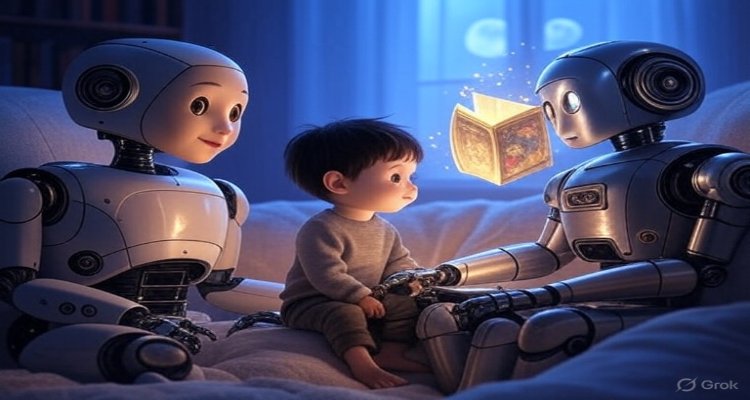Moonlit Robots: Bedtime Stories from the Future
In a world where technology meets imagination, “moonlit robots” redefine storytelling, blending AI, robotics, and culture to shape the future of bedtime tales.
Introduction: A New Kind of Bedtime Story
For centuries, bedtime stories have been a universal ritual—parents reading tales of magic, morality, and wonder as children drift into dreams. But in the near future, the gentle voice of a parent may be joined—or even replaced—by another presence: robots. Not just any robots, but intelligent, moonlit companions designed to weave interactive narratives under the soft glow of night. Welcome to the age of “moonlit robots,” where bedtime stories are reborn through the fusion of technology, imagination, and culture.
Context & Background: From Oral Tales to AI Narratives
Storytelling has always evolved alongside human society. Once passed around fire circles, stories later found permanence in books and eventually blossomed into digital media. Now, AI-driven narratives are pushing the tradition into uncharted territory.
Advancements in natural language processing, robotics, and holographic projection have given rise to interactive storytelling devices that can adapt tales to children’s emotions, responses, and even dreams. Unlike static storybooks, these AI-driven storytellers can personalize adventures in real time—transforming the listener from a passive audience into an active co-creator.
The idea of bedtime robots might sound futuristic, but prototypes are already in development in tech hubs across Asia, Europe, and Silicon Valley. They’re not cold, metallic machines—they’re designed to be soft, comforting, and emotionally intelligent.
Main Developments: Moonlit Robots Enter the Home
The new generation of “moonlit robots” doesn’t merely read preloaded stories. They respond to voice cues, track facial expressions, and adjust narratives dynamically. If a child looks frightened, the robot shifts the story’s tone; if curiosity sparks, it expands the plot.
Some models are equipped with holographic displays that cast glowing characters across bedroom walls, turning the room into an immersive theater. Others synchronize with smart home systems, dimming lights and projecting a moonlit ambiance to create a calming environment.
Tech startups are already pitching these robots as both educational tools and wellness aids. Parents, especially those balancing demanding jobs, see them as a way to maintain bedtime rituals even when time is short. Critics, however, warn of overreliance on machines for such intimate moments.
Expert Insight & Public Reaction
Dr. Leila Morgan, a child development psychologist, notes:
“Children thrive on emotional connection. If designed with care, these robots could supplement parental storytelling, not replace it. The danger lies in using technology as a substitute for human bonding.”
On the other side, futurist and author Raj Patel sees cultural opportunity:
“We’ve always shaped bedtime stories to reflect our world. Robots simply extend that tradition—blending myth with machine, and creating tales that prepare children for a future where humans and AI coexist.”
Public opinion remains divided. Some parents see moonlit robots as creative allies, while others worry about screen time, data privacy, and the loss of tradition. On social platforms, debates often mirror larger concerns about AI in daily life: progress versus preservation.
Impact & Implications: The Future of Storytelling
If moonlit robots gain traction, they could reshape early education, childhood imagination, and even intergenerational traditions. Future models might come equipped with multilingual storytelling features, introducing children to global folklore. Others may link with health trackers, monitoring sleep quality and tailoring stories to improve rest.
For industries, the implications are vast. EdTech companies, toy manufacturers, and entertainment giants are already eyeing partnerships to create “robotic storytellers” with libraries of licensed characters. Governments and educators, however, face new questions about regulation, child safety, and ethical design.
The larger question lingers: Will robots enhance the intimacy of storytelling, or will they erode it? The answer may depend on how families choose to integrate these glowing, whispering machines into their nightly routines.
Conclusion: Between Tradition and Tomorrow
Bedtime stories have always been more than entertainment—they are cultural bridges, shaping values, creativity, and comfort. “Moonlit robots” represent the next chapter in that evolution. Whether they become beloved companions or controversial intruders will depend on how humanity balances innovation with human touch.
As the night sky continues to inspire dreams, tomorrow’s children may not only hear stories beneath the moonlight—they may live them, alongside glowing robotic storytellers who whisper the future in their ears.
Disclaimer : This article explores speculative developments in AI and robotics. While based on current research and emerging trends, moonlit robots remain a conceptual innovation, not yet mainstream consumer products.











